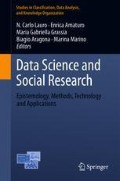Abstract
In the present contribution, the use of distributional semantic models (DSMs) is proposed as a novel approach for the analysis of crisis communication strategies. Temporal Random Indexing (TRI), a specific DSM framework, is employed as computational tool to analyse word meaning change over time. Our resource is represented by the CompWHoB (Computational White House press Briefings) Corpus, a political diachronic corpus collecting the transcripts of the White House Press Briefings from 1993 to 2014. Primary objective of this paper is to demonstrate that TRI can be used in conjunction with Critical Discourse Analysis (CDA) theories as an easily adaptable tool applicable to the analysis of the so-called crisis communication management moments where US administration has to cope with risky and serious scenarios.
Notes
- 1.
Department of Physics, University of Napoli Federico II.
- 2.
The CompWHoB Corpus is planned to be extended to the end of the Obama second term presidency.
- 3.
Global Terrorism Database—http://www.start.umd.edu/gtd/.
- 4.
Temporal Random Indexing—https://github.com/pippokill/tri.
- 5.
FrameNet Project—https://framenet.icsi.berkeley.edu/fndrupal/.
References
Auriemma, M., Esposito, E., Iadicicco, L., Marrazzo, F., Polimene, A., Punziano, G., et al. (2015). Euroscetticismo a 5 Stelle: Stili comunicativi e online text data nel caso delle elezioni europee 2014. Sociologia della Comunicazione.
Baker, C. F., Fillmore, C. J., & Lowe, J. B. (1998, August). The berkeley framenet project. In Proceedings of the 17th international conference on Computational linguistics (Vol. 1, pp. 86-90). Association for Computational Linguistics.
Baroni, M., & Lenci, A. (2010). Distributional memory: A general framework for corpus-based semantics. Computational Linguistics, 36(4), 673–721.
Basile, P., Caputo, A., & Semeraro, G. (2014, December). Analysing word meaning over time by exploiting temporal random indexing. In The First Italian Conference on Computational Linguistics CLiC-it 2014 (p. 38).
Brigadir, I., Greene, D., Cunningham, P., & (2015, July). Analyzing discourse communities with distributional semantic models. In ACM Web Science 2015 Conference, 28 June–1 July 2015, Oxford. United Kingdom: ACM.
Bruni, E., Tran, N. K., & Baroni, M. (2014). Multimodal distributional semantics. Journal of Artificial Intelligence Research (JAIR), 49, (1–47).
Coombs, W. T. (2007). Protecting organization reputations during a crisis: The development and application of situational crisis communication theory. Corporate reputation review, 10(3), 163–176.
Esposito, F., Basile, P., Cutugno, F., & Venuti, M. (2015, December). The CompWHoB Corpus: Computational Construction, Annotation and Linguistic Analysis of the White House Press Briefings Corpus. In Proceedings of the Second Italian Conference on Computational Linguistics CLiC-it 2015 (p. 120). Accademia University Press.
Fillmore, C. J. (1976). Frame semantics and the nature of language. Annals of the New York Academy of Sciences, 280(1), 20–32.
Harris, Z. S. (1954). Distributional structure. Word, 10(2–3), 146–162.
Kumar, M. J. (2007). Managing the president’s message. The White House communication operations Baltimore.
Mikolov, T., Sutskever, I., Chen, K., Corrado, G. S., & Dean, J. (2013). Distributed representations of words and phrases and their compositionality. In Advances in Neural Information Processing Systems (pp. 3111–3119).
Olteanu, A., Castillo, C., Diaz, F., & Vieweg, S. (2014, June). CrisisLex: A lexicon for collecting and filtering microblogged communications in crises. In ICWSM.
Reynolds, B., & Seeger, W. M. (2005). Crisis and emergency risk communication as an integrative model. Journal of health communication, 10(1), 43–55.
Sacks, H., (1992). Lectures on conversations (Vols. 1 and 2). Oxford: Blackwell.
Sperberg-McQueen, C. M., & Burnard, L. (2007). TEI P5: Guidelines for Electronic Text Encoding and Interchange.
Spinzi, C., & Venuti, M. (2013). Tracking the change in an institutional genre: A diachronic corpus-based study of white house press briefings. Newcastle upon Tyne: Cambridge Scholars Publishing.
Wodak, R. (2001). The discourse-historical approach. Methods of critical discourse analysis (pp. 63–94).
Author information
Authors and Affiliations
Corresponding author
Editor information
Editors and Affiliations
Rights and permissions
Copyright information
© 2017 Springer International Publishing AG
About this paper
Cite this paper
Esposito, F., Esposito, E., Basile, P. (2017). White House Under Attack. In: Lauro, N., Amaturo, E., Grassia, M., Aragona, B., Marino, M. (eds) Data Science and Social Research. Studies in Classification, Data Analysis, and Knowledge Organization. Springer, Cham. https://doi.org/10.1007/978-3-319-55477-8_16
Download citation
DOI: https://doi.org/10.1007/978-3-319-55477-8_16
Published:
Publisher Name: Springer, Cham
Print ISBN: 978-3-319-55476-1
Online ISBN: 978-3-319-55477-8
eBook Packages: Mathematics and StatisticsMathematics and Statistics (R0)

